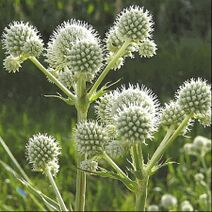Eryngium yuccifolium
| Eryngium yuccifolium | |
 | |
| Light: | |
| Moisture: | |
| Hardiness: | 4 |
| Soil pH: | 5.6-8.4 |
| Evergreen Self Pollinated | |
| Height: | 3' |
| Width: | 2' |
| Blooms: | Mid Summer-Early Fall |
| Native to: | |
| Nectary | |
| Medicinal Rating: | |
| Tea: | Yes |
Eryngium yuccifolium (common names: button eryngo and rattlesnake master) is an herbaceous perennial plant related to parsley. In North America, when found in the wild, it is an indicator plant of native prairie land.[1] The plant's root has been used as an antidote to snakebites[2] when chewed and applied topically to the bite as a poultice.[3][1]
Propagation: Seed - best sown as soon as it is ripe in early autumn on the surface of a well-drained compost in a cold frame[4]. The seed can also be sown in spring. It usually germinates in 5 - 90 days at 20°c. When they are large enough to handle, prick the seedlings out into individual pots and grow them on in the greenhouse for their first winter. Plant them out into their permanent positions in late spring or early summer, after the last expected frosts.
Division in early spring or autumn. Take care since the plant resents root disturbance[4].
Root cuttings in autumn or winter[4].
Cultivation: Requires a well-drained soil and a sunny position[5]. Prefers a light sandy soil but tolerates most soil types including lime and poor gravels[4].
Plants should be put in their final position whilst small since they resent root disturbance[4].
Range: Eastern N. America - Connecticut to Florida, west to Texas and Minnesota
Habitat: Dry to moist open woods, thickets and prairies[6].
Medicinal: The plant is diaphoretic, diuretic, emetic (in large doses), expectorant and febrifuge{46, 61].
A decoction of the roots has been found useful in cases of exhaustion from sexual depletion, with loss of erectile power, seminal emissions and orchitis[7]. A tincture of the roots is used in the treatment of female reproductive disorders[8].
The pounded roots are used as a diuretic.[3] An infusion of them is used to reduce fevers[3]. Chewing the root increases the flow of saliva[8].
Pollinators: Bees, flies, beetles
Soil: Can grow in light and medium soils.
Drainage: Prefers well drained soil.
Wind: Tolerates strong winds
In Leaf: Evergreen
Flower Type: Hermaphrodite
Links
References
- ↑ 1.0 1.1 Diggs, George and Barney Lipscomb. Illustrated Flora of North Central Texas. Botanical Research Institute, 1999.
- ↑ Moerman, Daniel. Native American Ethnobotany. Timber Press, 1998.
- ↑ 3.0 3.1 3.2 Weiner, Michael. Earth Medicine, Earth Food. Ballantine Books, 1980.
- ↑ 4.0 4.1 4.2 4.3 4.4 Huxley, Anthony. The New Royal Horticultural Society Dictionary of Gardening. MacMillan Press, 1992.
- ↑ Chittendon, Fred. RHS Dictionary of Plants. Oxford University Press, 1951.
- ↑ Lyndon, Merritt. Gray's Manual of Botany. American Book Co, 1950.
- ↑ Coffey, Timothy. The History and Folklore of North American Wild Flowers. Facts on File, 1993.
- ↑ 8.0 8.1 Foster, Steven and Billy Tatum. Medicinal Plants of Eastern and Central North America. Houghton Mifflin, 1990.